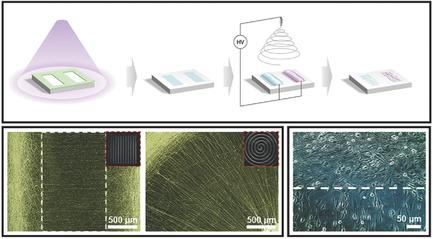当前位置:
X-MOL 学术
›
Adv. Mater. Interfaces
›
论文详情
Our official English website, www.x-mol.net, welcomes your
feedback! (Note: you will need to create a separate account there.)
Electrospinning Nanofiber on an Insulating Surface with a Patterned Functional Electrolyte Electrode
Advanced Materials Interfaces ( IF 4.3 ) Pub Date : 2018-01-12 , DOI: 10.1002/admi.201701204 Geon Hwee Kim 1 , Hyoryung Nam 2 , WooSeok Choi 3 , Taechang An 4 , Geunbae Lim 1
Advanced Materials Interfaces ( IF 4.3 ) Pub Date : 2018-01-12 , DOI: 10.1002/admi.201701204 Geon Hwee Kim 1 , Hyoryung Nam 2 , WooSeok Choi 3 , Taechang An 4 , Geunbae Lim 1
Affiliation

|
Electrodes in traditional electrospinning processes have been used to directly collect nanofibers, or to induce a modified electric field to collect aligned nanofibers. In this context, many studies have been carried out to overcome the limitations of simple metal electrodes. In this study, a sub‐millimeter‐scale electrospun nanofiber patterning technique is proposed, which uses a functional electrolyte as a collector electrode between an electrospun nanofiber and a collector substrate. Adhesion between nanofibers and substrate is promoted by using polydopamine solution as a functional electrolyte. In this method, after the electrospinning process is completed, the electrolyte used as the collector electrode is evaporated so that the nanofiber and the substrate are in direct contact, without any trace of the metal electrode. Nanofibers can also be patterned on a thick insulator using this fabrication method. This fabrication method combines the advantages of conventional wet‐electrospinning and electrospinning techniques with metal electrodes in terms of nanofiber patterning.
中文翻译:

在绝缘表面上使用图案化功能电解质电极静电纺丝纳米纤维
传统的静电纺丝工艺中的电极已被用来直接收集纳米纤维,或通过感应电场来收集对齐的纳米纤维。在这种情况下,已经进行了许多研究来克服简单金属电极的局限性。在这项研究中,提出了一种亚毫米级的电纺纳米纤维构图技术,该技术使用功能性电解质作为电纺纳米纤维与集电体基底之间的集电极。通过使用聚多巴胺溶液作为功能性电解质,可促进纳米纤维与基材之间的粘合。在该方法中,在完成静电纺丝工艺之后,蒸发用作集电极的电解质,从而使纳米纤维与基材直接接触,而没有任何金属电极的痕迹。使用这种制造方法,也可以在厚的绝缘体上对纳米纤维进行构图。这种制造方法结合了传统的湿法静电纺丝和静电纺丝技术与金属电极在纳米纤维图案方面的优势。
更新日期:2018-01-12
中文翻译:

在绝缘表面上使用图案化功能电解质电极静电纺丝纳米纤维
传统的静电纺丝工艺中的电极已被用来直接收集纳米纤维,或通过感应电场来收集对齐的纳米纤维。在这种情况下,已经进行了许多研究来克服简单金属电极的局限性。在这项研究中,提出了一种亚毫米级的电纺纳米纤维构图技术,该技术使用功能性电解质作为电纺纳米纤维与集电体基底之间的集电极。通过使用聚多巴胺溶液作为功能性电解质,可促进纳米纤维与基材之间的粘合。在该方法中,在完成静电纺丝工艺之后,蒸发用作集电极的电解质,从而使纳米纤维与基材直接接触,而没有任何金属电极的痕迹。使用这种制造方法,也可以在厚的绝缘体上对纳米纤维进行构图。这种制造方法结合了传统的湿法静电纺丝和静电纺丝技术与金属电极在纳米纤维图案方面的优势。











































 京公网安备 11010802027423号
京公网安备 11010802027423号